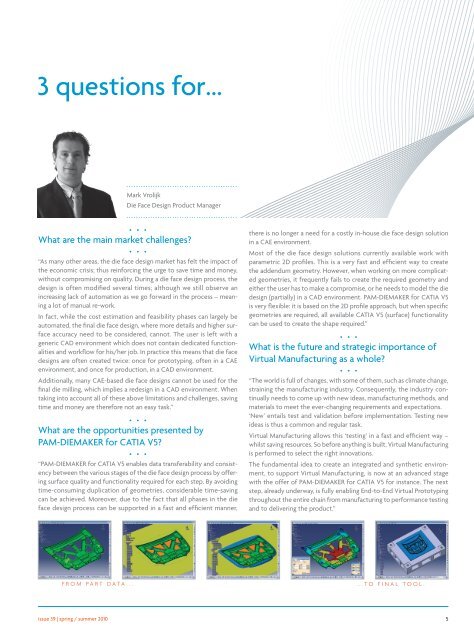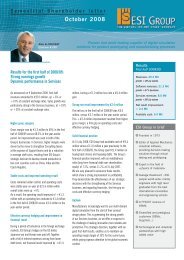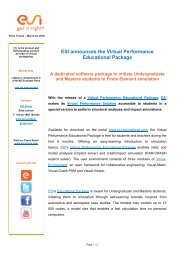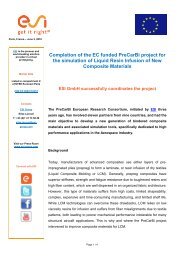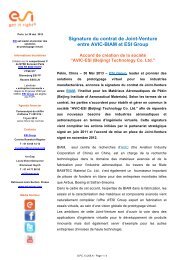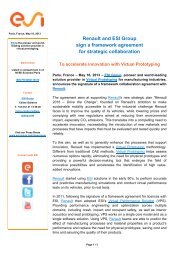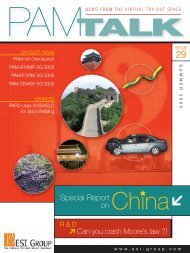Rapid Die Face Design: a step towards End-to-End ... - ESI Group
Rapid Die Face Design: a step towards End-to-End ... - ESI Group
Rapid Die Face Design: a step towards End-to-End ... - ESI Group
Create successful ePaper yourself
Turn your PDF publications into a flip-book with our unique Google optimized e-Paper software.
3 questions for…<br />
Mark Vrolijk<br />
<strong>Die</strong> <strong>Face</strong> <strong>Design</strong> Product Manager<br />
What are the main market challenges?<br />
“As many other areas, the die face design market has felt the impact of<br />
the economic crisis; thus reinforcing the urge <strong>to</strong> save time and money,<br />
without compromising on quality. During a die face design process, the<br />
design is often modified several times; although we still observe an<br />
increasing lack of au<strong>to</strong>mation as we go forward in the process – meaning<br />
a lot of manual re-work.<br />
In fact, while the cost estimation and feasibility phases can largely be<br />
au<strong>to</strong>mated, the final die face design, where more details and higher surface<br />
accuracy need <strong>to</strong> be considered, cannot. The user is left with a<br />
generic CAD environment which does not contain dedicated functionalities<br />
and workflow for his/her job. In practice this means that die face<br />
designs are often created twice: once for pro<strong>to</strong>typing, often in a CAE<br />
environment, and once for production, in a CAD environment.<br />
Additionally, many CAE-based die face designs cannot be used for the<br />
final die milling, which implies a redesign in a CAD environment. When<br />
taking in<strong>to</strong> account all of these above limitations and challenges, saving<br />
time and money are therefore not an easy task.”<br />
What are the opportunities presented by<br />
PAM-DIEMAKER for CATIA V5?<br />
“PAM-DIEMAKER for CATIA V5 enables data transferability and consistency<br />
between the various stages of the die face design process by offering<br />
surface quality and functionality required for each <strong>step</strong>. By avoiding<br />
time-consuming duplication of geometries, considerable time-saving<br />
can be achieved. Moreover, due <strong>to</strong> the fact that all phases in the die<br />
face design process can be supported in a fast and efficient manner,<br />
there is no longer a need for a costly in-house die face design solution<br />
in a CAE environment.<br />
Most of the die face design solutions currently available work with<br />
parametric 2D profiles. This is a very fast and efficient way <strong>to</strong> create<br />
the addendum geometry. However, when working on more complicated<br />
geometries, it frequently fails <strong>to</strong> create the required geometry and<br />
either the user has <strong>to</strong> make a compromise, or he needs <strong>to</strong> model the die<br />
design (partially) in a CAD environment. PAM-DIEMAKER for CATIA V5<br />
is very flexible: it is based on the 2D profile approach, but when specific<br />
geometries are required, all available CATIA V5 (surface) functionality<br />
can be used <strong>to</strong> create the shape required.”<br />
What is the future and strategic importance of<br />
Virtual Manufacturing as a whole?<br />
“The world is full of changes, with some of them, such as climate change,<br />
straining the manufacturing industry. Consequently, the industry continually<br />
needs <strong>to</strong> come up with new ideas, manufacturing methods, and<br />
materials <strong>to</strong> meet the ever-changing requirements and expectations.<br />
‘New’ entails test and validation before implementation. Testing new<br />
ideas is thus a common and regular task.<br />
Virtual Manufacturing allows this ‘testing’ in a fast and efficient way –<br />
whilst saving resources. So before anything is built, Virtual Manufacturing<br />
is performed <strong>to</strong> select the right innovations.<br />
The fundamental idea <strong>to</strong> create an integrated and synthetic environment,<br />
<strong>to</strong> support Virtual Manufacturing, is now at an advanced stage<br />
with the offer of PAM-DIEMAKER for CATIA V5 for instance. The next<br />
<strong>step</strong>, already underway, is fully enabling <strong>End</strong>-<strong>to</strong>-<strong>End</strong> Virtual Pro<strong>to</strong>typing<br />
throughout the entire chain from manufacturing <strong>to</strong> performance testing<br />
and <strong>to</strong> delivering the product.”<br />
F r o m p a r t d a t a . . . . . . t o F i n a l t o o l .<br />
issue 39 | spring / summer 2010 5


